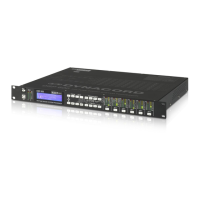DSP 600
29
Hi shelf (Hishelv)
The Hi-shelf filter is a “hinge” type; in that frequencies above its frequency setting can be boosted or cut; hinging on the
cut-off Frequency. The amount of boost or cut (Gain), and the width of the filter’s transition band (Slope), are deter-
mined by the hi-shelf filter’s settings. (See Response/Q and Gain.) Use the < SELECT > buttons to navigate to the filter
setting you wish to adjust, and the Value Up and Down buttons to alter these settings. Press the Value Up and Down
buttons once to increment values by one unit, or press and hold to scroll rapidly through available values. (Values do
not wrap-around.)
PEQ
PEQ is shorthand for Parametric Equalizer. A parametric equalizer has three parameters that determine the frequencies
that are affected by it; Center Frequency, Q (filter-width) and Gain. Parametric filters are ideal for identifying, isolating
and correcting problematic frequency ranges. The Frequency parameter determines the center of a range of frequencies
that will be adjusted by the PEQ. The Q parameter will determine the range of frequencies adjacent to the center fre-
quency that will also be effected; the greater the value, the smaller the range of adjacent frequencies that will be effect-
ed. The gain parameter determines the amount of boost or cut that is applied to the frequencies that are affected by
the filter. Use the < SELECT > buttons to navigate to the filter setting you wish to adjust, and the Value Up and Down
buttons to alter these settings. Press the Value Up and Down buttons once to increment values by one unit, or press
and hold to scroll rapidly through available values. (Values do not wrap-around.)
Low-pass (Lopass)
The Low-Pass filter determines the ultimate high frequency that your sound reinforcement system is allowed to repro-
duce; given the capabilities of amplifiers, speakers and transducers. The low-pass filter is useful for reducing excessive
high frequency energy that can create stress on high frequency transducers and listener fatigue. Available parameters
are Frequency and Slope. The frequency parameter determines the frequency above which frequencies will be attenu-
ated. The slope determines how quickly frequencies above the cutoff frequency will be attenuated. (See response
curve.)
Use the < SELECT > buttons to navigate to the filter setting you wish to adjust, and the Value Up and Down buttons to
alter these settings. Press the Value Up and Down buttons once to increment values by one unit, or press and hold to
scroll rapidly through available values. (Values do not wrap-around.)
High-pass (Hipass)
The Hi-Pass filter determines the ultimate low frequency that your sound reinforcement system is allowed to reproduce;
given the capabilities of amplifiers, speakers and transducers. Available parameters are Frequency and Slope. The fre-
quency parameter determines the frequency below which frequencies will be attenuated. The slope determines how
quickly frequencies below that will be attenuated. (See response curve.) Use the < SELECT > buttons to navigate to the
filter setting you wish to adjust, and the Value Up and Down buttons to alter these settings. Press the Value Up and
Down buttons once to increment values by one unit, or press and hold to scroll rapidly through available values. (Values
do not wrap-around.)
I
NPUT GRAPHIC EQ (GEQ)
Use the < SELECT > buttons to make the top line of the Edit screen active and the Value Up and Down but-
tons to navigate to the Input GEQ screen. The DSP 600’s input signal path includes a stereo 31-band graphic
equalizer after the stereo 10-band PEQ in the signal path. This DSP block can be used for very precisely iden-
tifying, isolating and correcting problematic frequency ranges. Keep in mind that changes to the Input GEQ
will be interactive with adjustments made in the Input PEQ. Unexpected results can occur.
Overview
Press the < SELECT > buttons to move the cursor down into the GEQ frequency adjustment field. Subsequent presses
of the < SELECT > buttons will move the cursor forward or backwards through the frequency adjustment field; from
band to band. The selected frequency’s “fader” is highlighted in the display. As each band is selected, its center fre-
quency and current cut/boost setting is displayed on the top line of the LCD display.
To adjust the amount of boost or cut for a selected frequency band, select the band with the < SELECT > buttons and
press the Value Up or Down buttons as required. The LCD display will reflect your changes by moving the selected fre-
quency band’s “fader” up or down.

